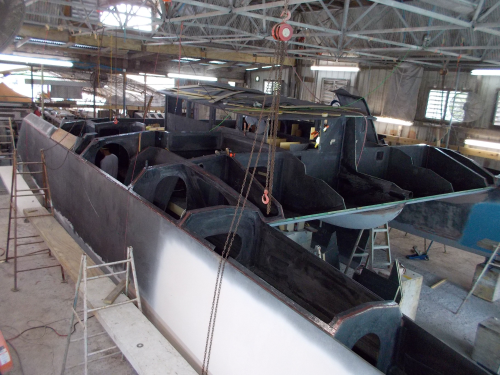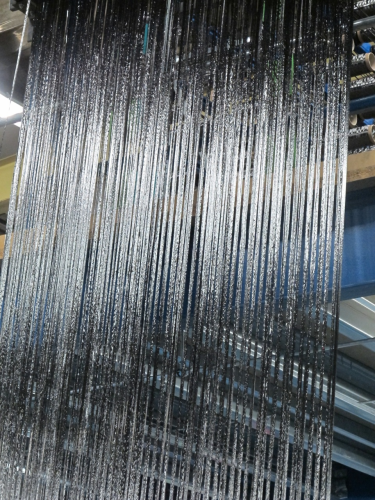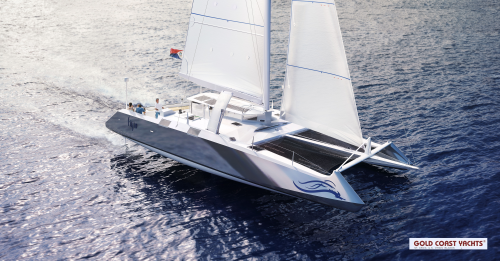


The B53 catamaran is designed by Paul Bieker of Bieker Boats LLC, who's known for engineering the AC72 foils for 2013 America's Cup winner Oracle Team USA. As well as being a very fast racer for competitive sailing, the B53 is also a modern, well-equipped cruiser. It has an overall length of 16.3 m, is 8 m wide, and has a draft of 0.4 m to 3 m with foils down. It has a displacement of 5500 kg, including most of the equipment.
Gold Coast Yachts, located in Christiansted on St. Croix in the US Virgin Islands, was formed in 1985 by Difede and designer Roger Hatfield. Over the years, the company has transitioned from wood/epoxy construction, to E-glass/foam core/epoxy composite using either resin infusion or wet bagging (vacuum bagging) techniques, and more recently, it has been incorporating more carbon composite parts. It is building the B53’a main structure, with the mast, rigging and foils, also in carbon, being supplied by other builders.
Infusion-optimised fabrics
The B53 owner and designer considered a number of composite build techniques. They did not think it would be possible to meet the weight and panel engineering requirements of the boat using wet bagging, but they were concerned that carbon could not be vacuum-infused successfully. Carbon fiber is significantly more difficult to infuse with resin than glass. This is because it has a smaller fiber diameter, which means carbon fibers can pack together more tightly, reducing the permeability of the fabric. Prepreg would be very expensive, requiring more costly materials, tooling and production equipment, and higher labour costs.
Formax's director of business development for North America, Philip Steggall, was enlisted to help Gold Coast Yachts decide which manufacturing process could best deliver the laminate properties (weight, strength and stiffness) set out by the designer. There followed a three-month testing programme involving close collaboration between Gold Coast Yachts and Formax, in which Formax fabrics were used to build identical laminate panels using the wet bagging and infusion techniques. A typical laminating resin was employed for the wet bag test panels, and an infusion-specific resin for the infusion samples. The panels were tested at laboratories in the US and Canada. The results demonstrated the improved properties of the infused panels, including a 15% increase in compression strength. With this data Gold Coast Yachts was able to prove that it could meet the B53's weight and engineering specifications using infusion, with relatively low cost moulds and lower post-curing temperatures than would be required for prepreg.
For the B53 Formax engineered new infusion-specific versions of its +45°/-45° biaxial carbon fiber fabrics of 400 g/m² and 300 g/m² and a 0°/90° biaxial of 300 g/m². Stitched multiaxials perform better in infusion than woven or hot-melt bonded fabrics because they offer a ‘z' axis for air to escape through the thickness, resulting in less voids. Formax also stitched ‘microweb' between the plies of the biaxial carbon fabric, which enhances the infusion and overall mechanical properties. Microweb is a polyamide random monofilament web that offers a path for air to escape and resin to flow between the layers of carbon reinforcement. Unlike a surface flow medium where the laminate is ‘flooded' with resin, microweb (at approximately 3 g/m² per 100 g/m² of carbon) allows for an even flow rate of resin through the thickness and across the surface of the laminate. The web also boosts impact resistance, and improves shear, compression, and flexural strength. The weight gain is minimal.
‘It was the Formax fabric which allowed us to get air out ahead of the resin front, instead of entrapping it within the laminate, as is done with wet bagging, and even with prepreg. That's how we hit the weight target, as well as the strength requirement, for this boat,’ reports Gold Coast Yachts' president Rich Difede. ‘Without this custom fabric, we would not have been as successful. We could have built the carbon boat, but not to this specification.’
And while the B53's strength, stiffness and weight specifications could also have been met with a prepreg construction, the cost would have been much higher. Gold Coast Yachts' designer Hatfield believes that while a boat like this might normally cost US$4 million in prepreg, the B53 will come in at around US$2.5 million when complete.
Minimising risk
Once the requirements for the fabric were determined, Formax delivered the order within six weeks. 99% of reinforcements used for the B53 were supplied by Formax.
Formax's Steggall then assisted in the next stage in the process – defining the manufacturing process for building the boat itself, which involved the manufacture of large parts with a high dollar risk associated with them. He helped train the Gold Coast Yachts staff to identify risks that could cause a failure in every step of the process, from monitoring and verifying equipment, to the temperature of part and resin to optimise viscosity and flow rate, to organising the crew to operate as a team under the guidance of one team leader.
Gold Coast Yachts was happy with this improved build process. It started out with smaller, less highly structurally-loaded panels to validate the process before moving on to the larger components. Some parts were male-moulded, with others using female moulds. Some parts were produced in a one shot process – skin-core-skin all being infused together. To save weight, parts with a complicated geometry were built in a three-stage process: the outer skin was resin infused first, the core installed, and then the inner skin infused.
Building on the success of the B53, Gold Coast Yachts is getting ready for its next project, a bigger boat, which will employ the same combination of Formax multiaxials and resin infusion. The company also plans to continue testing work to compare the properties obtained using resin infusion with those of the prepreg process.
‘Some remain sceptical about the quality and properties of infused carbon laminates,’ said Philip Steggall. ‘Our work with GCY, including many test panels in wet bagged and infusion, proved that infusion, when done correctly, yields a significant strength advantage. Part of the story is training of the personnel and part is material choice. Formax has infusion-specific materials and that's a huge help to customers.’
The boat is almost complete and on schedule to be launched in late March 2015. Owner Greg Slyngstad is expected to be sailing it in April. ‘The availability of Formax to work with us and produce the fabrics that we needed allowed this project to be completed successfully with resin infusion, and obtain properties very similar to those of a prepreg build at significantly lower cost,’ said Difede.






